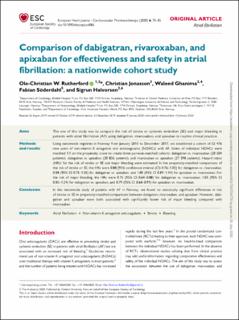| dc.contributor.author | Rutherford, Ole-Christian Walter | |
| dc.contributor.author | Jonasson, Christian | |
| dc.contributor.author | Ghanima, Waleed Khalid | |
| dc.contributor.author | Halvorsen, Sigrun | |
| dc.date.accessioned | 2020-08-21T07:23:22Z | |
| dc.date.available | 2020-08-21T07:23:22Z | |
| dc.date.created | 2020-01-22T10:54:32Z | |
| dc.date.issued | 2020 | |
| dc.identifier.citation | European Heart Journal (EHJ) - Cardiovascular Pharmacotherapy. 2020, 6 (2), 75–85 | en_US |
| dc.identifier.issn | 2055-6837 | |
| dc.identifier.uri | https://hdl.handle.net/11250/2673300 | |
| dc.description.abstract | The aim of this study was to compare the risk of stroke or systemic embolism (SE) and major bleeding in patients with atrial fibrillation (AF) using dabigatran, rivaroxaban, and apixaban in routine clinical practice.
Methods and results
Using nationwide registries in Norway from January 2013 to December 2017, we established a cohort of 52 476 new users of non-vitamin K antagonist oral anticoagulants (NOACs) with AF. Users of individual NOACs were matched 1:1 on the propensity score to create three pairwise-matched cohorts: dabigatran vs. rivaroxaban (20 504 patients), dabigatran vs. apixaban (20 826 patients), and rivaroxaban vs. apixaban (27 398 patients). Hazard ratios (HRs) for the risk of stroke or SE and major bleeding were estimated. In the propensity-matched comparisons of the risk of stroke or SE, the HRs were 0.88 [95% confidence interval (CI) 0.76–1.02] for dabigatran vs. rivaroxaban, 0.88 (95% CI 0.75–1.02) for dabigatran vs. apixaban, and 1.00 (95% CI 0.89–1.14) for apixaban vs. rivaroxaban. For the risk of major bleeding, the HRs were 0.75 (95% CI 0.64–0.88) for dabigatran vs. rivaroxaban, 1.03 (95% CI 0.85–1.24) for dabigatran vs. apixaban, and 0.79 (95% CI 0.68–0.91) for apixaban vs. rivaroxaban.
Conclusion
In this nationwide study of patients with AF in Norway, we found no statistically significant differences in risk of stroke or SE in propensity-matched comparisons between dabigatran, rivaroxaban, and apixaban. However, dabigatran and apixaban were both associated with significantly lower risk of major bleeding compared with rivaroxaban. | en_US |
| dc.language.iso | eng | en_US |
| dc.publisher | Oxford University Press on behalf of the European Society of Cardiology | en_US |
| dc.rights | Navngivelse 4.0 Internasjonal | * |
| dc.rights.uri | http://creativecommons.org/licenses/by/4.0/deed.no | * |
| dc.title | Comparison of dabigatran, rivaroxaban and apixaban for effectiveness and safety in atrial fibrillation; a nationwide cohort study | en_US |
| dc.type | Peer reviewed | en_US |
| dc.type | Journal article | en_US |
| dc.description.version | publishedVersion | en_US |
| dc.source.pagenumber | 75–85 | en_US |
| dc.source.volume | 6 | en_US |
| dc.source.journal | European Heart Journal (EHJ) - Cardiovascular Pharmacotherapy | en_US |
| dc.source.issue | 2 | en_US |
| dc.identifier.doi | 10.1093/ehjcvp/pvz086 | |
| dc.identifier.cristin | 1779824 | |
| dc.description.localcode | © The Author(s) 2020. This is an Open Access article distributed under the terms of the Creative Commons Attribution License (http://creativecommons.org/licenses/by/4.0/), which permits unrestricted reuse, distribution, and reproduction in any medium, provided the original work is properly cited. | en_US |
| cristin.ispublished | true | |
| cristin.fulltext | original | |
| cristin.qualitycode | 1 | |

